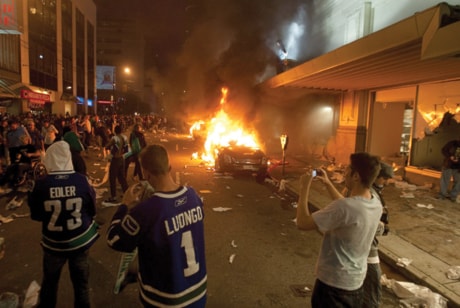VANCOUVER — Stories have been mounting of people photographed and videotaped in the chaos of Vancouver’s Stanley Cup riot who’ve had their lives upended — lost jobs, endangered sports careers, physical threats, online ridicule.
It’s only likely to grow, as an online public shaming campaign yields more photos and names every day and police prepare to use some of those images as evidence in criminal cases.
In another famous case, online media was used to shame a U.S. Congressman out of office. Anthony David Weiner was foolish enough to post pictures he apparently took of his own crotch — an example perhaps of using social media to commit career suicide.
The phenomenon is raising new questions about privacy and surveillance in a world where few public spaces are free from the gaze of a cellphone camera, particularly when those public spaces turn into crime scenes.
It gives both police and online vigilantes new ways to easily identify their targets.
The melee spanned several hours last Wednesday after the Canucks lost to the Boston Bruins, as jersey-clad rioters set fire to cars, smashed windows and looted stores, causing millions of dollars in damage. About 150 people were injured and there have been more than 100 arrests.
Before the night was over, websites and Facebook groups had already sprung up to help identify the perpetrators, using the countless photos and videos from onlookers and media reports.
Vancouver’s police department has received thousands of tips and photos and investigators are asking the public for more. The police are also warning people not to take the law into their own hands, with some alleged rioters complaining about threats, even going into hiding.
Josh Greenberg, an specialist in social media at Carleton University in Ottawa, says social media have given rise to a new form of surveillance.
Rather than Big Brother watching the public’s every move, citizens are equipped to watch each other.
But the real danger, says Greenberg, is how citizens have been using those photos and videos online, effectively meting out punishment before the police and courts figure out what actually happened. The online pressure has been so great, some young people who’ve been subjected to it have offered public apologies.
“A lot of people are leaping to conclusions that people were involved in the commission of a crime but police and the criminal justice system have the ability to make those determinations,” says Greenberg.
On the other hand, there may be positive spinoffs from the high-profile online shaming rioters have endured. Now that people know the consequences, they may think twice before behaving badly in public.
“The scale of the response has been far greater than any in the past,” says Greenberg. “It’s the kind of event that will service as a bit of a wake-up call for people that what they do in public does bear some consequences.”
Social media as a form of public court are even being used by police in this incident.
Vancouver’s police chief is lashing out against critics who say officers should have followed recommendations of a report from a 1994 riot in the city, saying the man claiming to have written it did no such thing.
Jim Chu said Tuesday in a letter to staff that Bob Whitelaw has made “misleading” comments about the Vancouver Police Department’s failures in responding to last week’s riot.
Chu, who encouraged staff to share the letter with friends and family — presumably online — said an earlier report by Whitelaw on the 1994 riot was rejected by the B.C. Police Commission and that a new report didn’t use of any of his material.
“Many of Mr. Whitelaw’s recommendations in his discarded report were rejected as unrealistic, and recommended a police reaction disproportionate to the offence being committed,” Chu said.
“Can you imagine the public outcry if we had zero tolerance on horn honking?”
Chu said a variety news organizations have interviewed Whitelaw as an expert since last week’s riot.
Whitelaw’s comments have been fodder for comment in online chat rooms and traditional media.
But that the former civil servant’s statements aren’t based on any expertise, and Chu is currently using social media to promote that message.
In any case, it’s unclear how useful the eyewitness photos and videos will be in convicting alleged instigators of the riot.
Vancouver-based criminal lawyer Eric Gottardi says police and prosecutors will need to use photos along with other evidence, including eyewitness testimony, to prove cases beyond a reasonable doubt.
“You move to the outliers, where all you have is one photo of someone posing in front of a burning car or in front of a broken window,” says Gottardi, who chairs the criminal justice section of the Canadian Bar Association’s B.C. branch.
“What is the photo evidence of? Is it evidence of mere presence at the riot? If so, I think the Crown will be hard-pressed to lay any criminal charges.”
